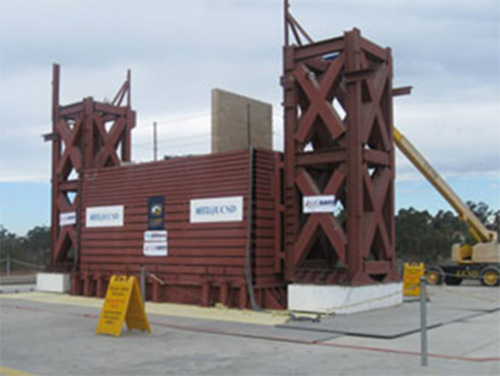The objective of the research project on retaining walls is to develop improved and validated rational guidelines for seismic design of retaining walls to overcome the drawbacks in the existing Caltrans design specification and tools. The research work involves 2 separate validation tests on two full-size retaining walls (each wall is about 8.5 feet long and 6 feet high Type 1 Semi-Gravity Reinforced Concrete Cantilever Wall, with a total height of 7.5 feet including a 1.5 feet thick bottom footing).
The first test includes one retaining wall without sound wall and the second test includes a sound wall on top of the second retaining wall. The walls will be backfilled with typical Caltrans soil from the soil pit at the UCSD site and supported on 3.5 feet of soil inside a large (2.85 x 6.7 x 3.66 meter) steel laminar soil shear box which will be mounted onto the shake table. Two end towers will be placed next to the box to create a rigid box for the tests. A water-proof liner will be position inside the box around all four vertical and bottom box surfaces to retain the soil. A second liner will then be placed inside the box separated from the first liner by a 1.5 inch layer of Bentonite material.
The wall and soil will be extensively instrumented to acquire measurements of accelerations, displacements, strains, earth/soil pressures, etc, during the shaking. Each soil-foundation system will be tested under a series of earthquakes starting with slow motions with low amplitude and culminating with severe earthquake motions (e.g., Northridge record, M=6.7). The outcome of this research will ensure that future retaining wall systems are designed to a higher performance standard and existing systems are upgraded to offer satisfactory performance.
Results
From this study, concrete cracking along the joint between the footing and stem was observed in both test specimens. This was the same location where the rebar was failing in tension. Also, in the test with sound wall, there was mortar cracking seen along the seam between the retaining wall and the sound wall. These appear to be the critical areas that may need to be examined in the design, especially under high intensity earthquakes where significant amount of bending is expected in the retaining wall and sound wall.
Based on the results of this project, the retaining wall with sound wall shall not be designed the same way as the retaining wall without sound wall because of the different pressure distributions between the two tests. The pressure trend of the retaining wall without the sound wall has a similar pressure trend as the Mononobe-Okabe method, so the active resultant of pressure acts at one-third the height of the stem, which is the same location as the theoretical resultant based on the Coulomb and Rakine theories. The resultant of the active pressure for wall with sound wall does not act at one-third the height but at a taller height on the stem in this project.

Investigators
| PI | Lijuan Cheng | University of California Davis |
| Co-PI | Dr. Boris Jeremic | University of California Davis |
| Student | Erin Mock | University of California Davis |
| Student | Charikleria Prassa | University of California Davis |
Contact
Dr. Lijuan "Dawn" Cheng
dawcheng@ucdavis.edu